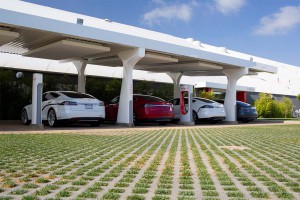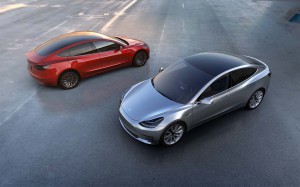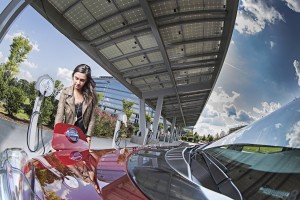There’s no such thing as a free lunch – or free energy, it seems. Tesla Motors plans to stop offering unlimited use of its cross-continent network of high-speed Superchargers to anyone who buys one of its vehicles after January 1, 2017.
The system, which currently includes 734 chargers worldwide, most in the U.S. and Canada, allows motorists to travel long distances without range anxiety. Until now, they have been open to any Tesla owner at no charge. The battery-carmaker hasn’t said what it will now charge new buyers but claims it will “cost less than the price of filling up a comparable gas car.”
Tesla had already signaled it would not include free charging for buyers of the Model 3, which is expected to go into production during the second half of 2017. The company says it now has more than 300,000 advance registrations on the books. And to help ensure it meets the aggressive production ramp-up outlined by CEO Elon Musk last March, Tesla is now buying Grohmann Engineering, a German firm that develops automated manufacturing systems for batteries.
(Chevrolet gets jump on competition as Bolt production begins. Click Here for the latest.)
Tesla has long struggled to boost its manufacturing operations. It is just now approaching a rate of 2,000 vehicles a week after falling well below its target earlier this year due to problems with the Model X battery sport-utility vehicle.
But the real test will come with next year’s Model 3 roll-out. At a preview of the new electric sedan on March 31, Musk said the goal would be to produce 500,000 battery vehicle in 2018, a massive increase that has generated plenty of skepticism among investors and analysts. Tesla has so far missed both launch dates and production targets on all of its earlier models.
Getting ready for the rollout of the Model 3 has strained Tesla’s budget, though Musk recently told financial analysts that the company does not expect to have to raise additional capital this year. But there is general consensus that Tesla is reining in spending where possible. And one area now appears to be in the operation of its Supercharger network.
(Tesla delivers unexpectedly strong Q3 profit. Click Here for details.)
These are so-called Level III systems using high-voltage direct current to radically reduce the time needed to charge. Depending upon the size of the vehicle’s battery pack, an owner can get an 80% recharge in as little as 15 minutes to half an hour, a fraction of the time needed by conventional Level II 220V AC chargers.
Tesla has said that it wants to eventually have enough Superchargers in place that an owner would never be farther than 90 miles away from one. And they are far closer along both the East and West Coasts and some key, cross-country routes.
Access to the Supercharger system has been a drawing card for Tesla, especially with buyers who might have to travel significant distances. It makes it easy to go from San Francisco to Los Angeles, about an eight-hour drive, for example, with only one stop using the current Tesla models.
Going forward, Tesla says new buyers will get 1,000 miles of credits to use at the Superchargers. It declined to respond when asked by TheDetroitBureau.com how much additional miles will cost.
The average price of electricity in the U.S. is $0.129 per kilowatt-hour. Recharging a Tesla Model S 70d would cost $9.03 if the battery were completely discharged. The maker’s longest-range Model S P100d, which gets slightly more than 300 miles, according to the EPA, would cost $12.90. That doesn’t account for the fact that many home chargers are timed to operate overnight using special lower electric rates. In some cases, that can be as little as $0.02 per kWh, or just $2.00 to recharge the P100d.
Even as Tesla has announced plans to charge for charging, key competitor Nissan has been expanding its free energy program — though it has not set up its own nationwide network of high-speed chargers. Whether the lack of free charging might impact demand for Tesla products is uncertain, though analysts think it will largely be ignored by potential buyers.
The bigger issue will be getting both Tesla’s new Gigafactory battery plant and its vehicle assembly line in Fremont, California ready for the launch of the new Model 3.
“To date, we have increased the production rate at our Fremont Factory by 400 percent in four years, and we expect this acquisition to accelerate that growth rate,” Tesla said in a blogpost announcing the acquisition of Grohmann Engineering.
Financial details have not been revealed, and the deal must still win approval from German regulators. If it gets the go, Grohmann is expected to add 1,000 more jobs to its current headcount of 700. Some key manufacturing systems for Tesla plants will be assembled in Germany by the company which will be renamed Tesla Grohmann Automation.
(Feds launch 25,000-mile Alt-Fuel Highway network. Click Here for the story.)



